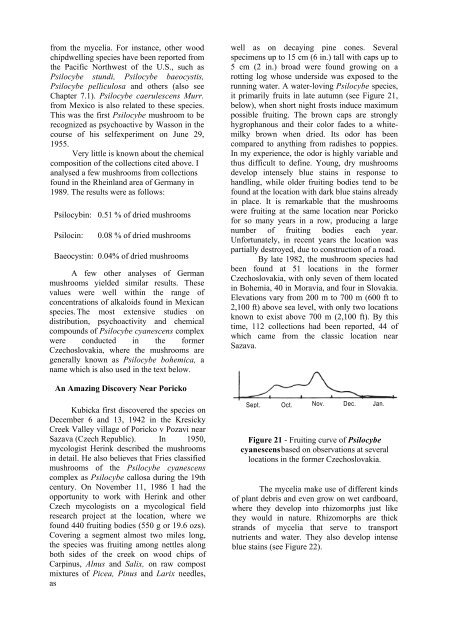Jochen Gartz - Magic Mushrooms Around the ... - preterhuman.net
Jochen Gartz - Magic Mushrooms Around the ... - preterhuman.net
Jochen Gartz - Magic Mushrooms Around the ... - preterhuman.net
Create successful ePaper yourself
Turn your PDF publications into a flip-book with our unique Google optimized e-Paper software.
from <strong>the</strong> mycelia. For instance, o<strong>the</strong>r wood<br />
chipdwelling species have been reported from<br />
<strong>the</strong> Pacific Northwest of <strong>the</strong> U.S., such as<br />
Psilocybe stundi, Psilocybe baeocystis,<br />
Psilocybe pelliculosa and o<strong>the</strong>rs (also see<br />
Chapter 7.1). Psilocybe caerulescens Murr.<br />
from Mexico is also related to <strong>the</strong>se species.<br />
This was <strong>the</strong> first Psilocybe mushroom to be<br />
recognized as psychoactive by Wasson in <strong>the</strong><br />
course of his selfexperiment on June 29,<br />
1955.<br />
Very little is known about <strong>the</strong> chemical<br />
composition of <strong>the</strong> collections cited above. I<br />
analysed a few mushrooms from collections<br />
found in <strong>the</strong> Rheinland area of Germany in<br />
1989. The results were as follows:<br />
Psilocybin: 0.51 % of dried mushrooms<br />
Psilocin:<br />
0.08 % of dried mushrooms<br />
Baeocystin: 0.04% of dried mushrooms<br />
A few o<strong>the</strong>r analyses of German<br />
mushrooms yielded similar results. These<br />
values were well within <strong>the</strong> range of<br />
concentrations of alkaloids found in Mexican<br />
species. The most extensive studies on<br />
distribution, psychoactivity and chemical<br />
compounds of Psilocybe cyanescens complex<br />
were conducted in <strong>the</strong> former<br />
Czechoslovakia, where <strong>the</strong> mushrooms are<br />
generally known as Psilocybe bohemica, a<br />
name which is also used in <strong>the</strong> text below.<br />
well as on decaying pine cones. Several<br />
specimens up to 15 cm (6 in.) tall with caps up to<br />
5 cm (2 in.) broad were found growing on a<br />
rotting log whose underside was exposed to <strong>the</strong><br />
running water. A water-loving Psilocybe species,<br />
it primarily fruits in late autumn (see Figure 21,<br />
below), when short night frosts induce maximum<br />
possible fruiting. The brown caps are strongly<br />
hygrophanous and <strong>the</strong>ir color fades to a whitemilky<br />
brown when dried. Its odor has been<br />
compared to anything from radishes to poppies.<br />
In my experience, <strong>the</strong> odor is highly variable and<br />
thus difficult to define. Young, dry mushrooms<br />
develop intensely blue stains in response to<br />
handling, while older fruiting bodies tend to be<br />
found at <strong>the</strong> location with dark blue stains already<br />
in place. It is remarkable that <strong>the</strong> mushrooms<br />
were fruiting at <strong>the</strong> same location near Poricko<br />
for so many years in a row, producing a large<br />
number of fruiting bodies each year.<br />
Unfortunately, in recent years <strong>the</strong> location was<br />
partially destroyed, due to construction of a road.<br />
By late 1982, <strong>the</strong> mushroom species had<br />
been found at 51 locations in <strong>the</strong> former<br />
Czechoslovakia, with only seven of <strong>the</strong>m located<br />
in Bohemia, 40 in Moravia, and four in Slovakia.<br />
Elevations vary from 200 m to 700 m (600 ft to<br />
2,100 ft) above sea level, with only two locations<br />
known to exist above 700 m (2,100 ft). By this<br />
time, 112 collections had been reported, 44 of<br />
which came from <strong>the</strong> classic location near<br />
Sazava.<br />
An Amazing Discovery Near Poricko<br />
Kubicka first discovered <strong>the</strong> species on<br />
December 6 and 13, 1942 in <strong>the</strong> Kresicky<br />
Creek Valley village of Poricko v Pozavi near<br />
Sazava (Czech Republic). In 1950,<br />
mycologist Herink described <strong>the</strong> mushrooms<br />
in detail. He also believes that Fries classified<br />
mushrooms of <strong>the</strong> Psilocybe cyanescens<br />
complex as Psilocybe callosa during <strong>the</strong> 19th<br />
century. On November 11, 1986 I had <strong>the</strong><br />
opportunity to work with Herink and o<strong>the</strong>r<br />
Czech mycologists on a mycological field<br />
research project at <strong>the</strong> location, where we<br />
found 440 fruiting bodies (550 g or 19.6 ozs).<br />
Covering a segment almost two miles long,<br />
<strong>the</strong> species was fruiting among <strong>net</strong>tles along<br />
both sides of <strong>the</strong> creek on wood chips of<br />
Carpinus, Alnus and Salix, on raw compost<br />
mixtures of Picea, Pinus and Larix needles,<br />
as<br />
Sept. Oct. Nov. Dec. Jan.<br />
Figure 21 - Fruiting curve of Psilocybe<br />
cyanescens based on observations at several<br />
locations in <strong>the</strong> former Czechoslovakia.<br />
The mycelia make use of different kinds<br />
of plant debris and even grow on wet cardboard,<br />
where <strong>the</strong>y develop into rhizomorphs just like<br />
<strong>the</strong>y would in nature. Rhizomorphs are thick<br />
strands of mycelia that serve to transport<br />
nutrients and water. They also develop intense<br />
blue stains (see Figure 22).








![The Big Lie 9-11 and Government Complicity in Mass Murder [PDF]](https://img.yumpu.com/50957077/1/190x245/the-big-lie-9-11-and-government-complicity-in-mass-murder-pdf.jpg?quality=85)








